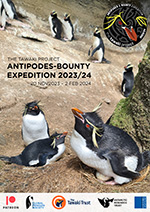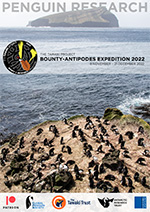
The Tawaki Project returns to Antipodes Island in November 2023 for an extended stay until the end of January 2024 with a short visit to the Bounties on the way home. This provides the opportunity to conduct an extended GPS logger study on both Erect-crested and Eastern Rockhopper penguins during the chick-guard and crèching stage of breeding. Drone surveys are flown and satellite transmitters deployed on Erect-crested penguins to study the species pre-moult dispersal after the conclusion of the breeding season.
Standard quality: TawakiProject_Antipodes-Bounty-Expedition-2023_24-small.pdf (14.4 mb)
High quality: TawakiProject_Antipodes-Bounty-Expedition-2023_24.pdf (41.6 m)

Four years in the making, the Tawaki Project in November 2022 finally embarked on the first expedition to the subantarctic Bounty and Antipodes Islands to conduct the first complete population census of the endangered Erect-crested penguin and study the species foraging ecology. The species is the least known and, given its threat ranking, severely understudied penguin species. This expedition represents the first scientific study of the species in 25 years and is planned to be the beginning of a series of expeditions aiming to uncover the secret life of Tawaki nana hī.
Standard quality: TawakiProject_Bounty-Antipodes-Expedition-2022-small.pdf (9.7 mb)
High quality: TawakiProject-Bounty-Antipodes-Expedition-2022.pdf (18.9 mb)
“After completing its first phase (2014-2019), that compared the marine ecology and breeding success of tawaki across their distributional range, the Tawaki Project entered the second phase in the 2019/2020 breeding season. Our previous work not only found that tawaki are extremely versatile in their foraging behaviour which allows them to thrive in highly variable marine conditions. The second phase of the project, therefore, focuses on the ecology of tawaki throughout their Fiordland range….“
Standard quality: TawakiProject-FieldReport-Year-7-small.pdf (1.43 mb)
High quality: TawakiProject-FieldReport-Year-7.pdf (27.1 mb)
“In the breeding season 2019, the Tawaki Project completed its sixth field season and entered a new phase of research. The first five years of the project examined how the species’ foraging ecology and population dynamics varied across the entire tawaki breeding distribution. The next phase of the Tawaki Project will investigate how the penguins fit into the marine ecosystem of New Zealand’s fjords, and whether Fiordland provides a safe haven for tawaki in an era of substantial global changes…“
Standard quality: TawakiProject-FieldReport-Year-6-small.pdf (1.53 mb)
High quality: TawakiProject-FieldReport-Year-6.pdf (18.2 mb)
“Since 2014, the Tawaki Project has been studying the foraging behaviour, reproductive success and population developments of Fiordland penguins/tawaki across the species’ breeding range. Starting in 2016, the project operated at three sites representing the penguins diverse foraging habitat: Jackson Head on the West Coast, Harrison Cove, Milford Sound/Piopiotahi in Fiordland, and Codfish Island/Whenua Hou in the Foveaux Strait…“
Standard quality: TawakiProject-FieldReport2018-small.pdf (4.2 mb)
High quality: TawakiProject-FieldReport2018.pdf (12.1 mb)
“The fourth year of the Tawaki Project has been the most ambitious in terms of scope of research questions that were addressed. Over the first three years, the project slowly ramped up from working at one (Jackson Head/West Coast), then two (Milford Sound/Piopiotahi), and finally three sites (Codfish Island/Whenua Hou) simultaneously to study how breeding Fiordland penguins / tawaki interact with their diverse marine habitats...”
Standard quality: TawakiProject-FieldReport2017-small.pdf (4.0 mb)
High quality: TawakiProject-FieldReport2017.pdf (9.6 mb)
“In 2015, the Tawaki Project included Harrison Cove in Milford Sound as a second study site besides its established West Coast site at Jackson Head. The second year of research coincided with a very strong El Niño which affected penguins from both sites differently. In its third year, the Tawaki Project finally expanded its research activities to cover the species’ full breeding extent operating at four sites: Jackson Head, Gorge River, Milford Sound and Codfish Island / Whenua Hou…”
Standard quality: TawakiProject-FieldReport2016-small.pdf (1.0 mb)
High quality: TawakiProject-FieldReport2016.pdf (9.3 mb)
“After a successful pilot study conducted in 2014, the Tawaki Project moved into its first fully focused season of foraging research on Fiordland penguins/tawaki in September 2015. The pilot study had shown that research involving deployment of data loggers on a penguin species that is considered extremely sensitive to human presence was indeed feasible. While the penguins proved to be a cautious species, they were considerably more tolerant to research interactions than previously thought…”
Standard quality: TawakiProject-FieldReport2015-small.pdf (3.2 mb)
High quality: TawakiProject-FieldReport2015.pdf (7.2 mb)
“The year 2014 saw the realisation of a project that had a considerable gestation time. The need for more research on the enigmatic Fiordland penguins/tawaki was highlighted in Graeme Taylor’s ‘Action Plan for Seabird Conservation in New Zealand‘ in the year 2000. Investigations of the species’ marine ecology – their foraging ranges, diving behaviour and diet composition – all ranged high in the priority list of required research. ..”
Standard quality: TawakiProject-FieldReport2014-small.pdf (1.3 mb)
High quality: TawakiProject-FieldReport2014.pdf (15.5 mb)
“The enigmatic Fiordland crested penguin (Eudyptes pachyrhynchus) or tawaki is one of the rarest penguins worldwide. It is also one of the penguin species we know the least about. Only a handful of studies have been conducted so far, the majority of which focussed on aspects of the penguins’ terrestrial biology such as breeding behaviour and population counts. The IUCN red list ranks tawaki as ‘vulnerable’ due to its low population size (~5,000 mature birds) and apparent decline. In New Zealand, tawaki are ranked ‘nationally vulnerable’ with an estimated rate of decline between 10-50% over the course of just 10 years…”
Standard quality: TawakiProject-ResearchPlan-year1-2014.pdf (1.1 mb)